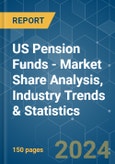The US Pension Funds Market size in terms of assets under management value is expected to grow from USD 6.14 trillion in 2024 to USD 9.40 trillion by 2029, at a CAGR of 8.90% during the forecast period (2024-2029).
A pension fund is an investment made to provide for retirement income. Pension funds have traditionally invested in bonds and equities with long-term investment horizons, and given the market volatility, they have diversified their portfolios by allocating funds to alternatives like hedge funds, private equity, real estate, and others. COVID-19 had a negative impact on various economies, which resulted in impacting retirement savings, retirement savings schemes, providers, regulators, and supervisors, potentially leading to further lowering the income from the retirement fund market.
In recent years, the market has witnessed intense reform efforts in countries around the globe, often involving increased use of funded pension programs managed by the private sector. These funded arrangements are likely to play an increasingly important role in delivering retirement income in many countries, and privately managed pension assets will play an increasing role in financial markets, notably as a source of long-term savings.
This product will be delivered within 2 business days.
A pension fund is an investment made to provide for retirement income. Pension funds have traditionally invested in bonds and equities with long-term investment horizons, and given the market volatility, they have diversified their portfolios by allocating funds to alternatives like hedge funds, private equity, real estate, and others. COVID-19 had a negative impact on various economies, which resulted in impacting retirement savings, retirement savings schemes, providers, regulators, and supervisors, potentially leading to further lowering the income from the retirement fund market.
In recent years, the market has witnessed intense reform efforts in countries around the globe, often involving increased use of funded pension programs managed by the private sector. These funded arrangements are likely to play an increasingly important role in delivering retirement income in many countries, and privately managed pension assets will play an increasing role in financial markets, notably as a source of long-term savings.
US Pension Funds Market Trends
Asset Allocations in Pension Funds is Driving the Market
Asset allocation has been at the center of investment decision-making for many funds. A pension fund is an investment made to provide for retirement income. These funds are normally invested in equity bonds and other instruments with lower risk for a long-term period. Various distributions of the funds are done to minimize the risk and maximize the returns over the long term. The average Fortune 1000 pension plan held an average of over USD 4.9 billion in assets at the year-end of 2021. The average allocation to public equity was more than 30%, while the average debt allocation was more than 50%. Asset allocation involves dividing your investments among different assets, such as stocks, bonds, and cash. This allocation in the pension fund market in the US shows that players have diversified their portfolios. This will drive the market, as it will have a positive impact on the returns on investment.Increasing Retirement Assets Is Driving the Market
At the end of December 2022, retirement assets made up 30% of all financial assets owned by households in the United States. Total US retirement assets were USD 33.6 trillion as of December 31, 2022, 3.9 percent up from September. Individual retirement accounts (IRAs) hold the most retirement assets, at 34% of the total. Since 2012, they doubled, jumping from USD 5.8 trillion to USD 11.7 trillion in 2022. The overall US retirement assets were more than USD 33 trillion as of 2022. Pension funds are a way of making your financial investments future-proof, as after retirement a person should have funds to keep their standard of living constant. Various economies across the globe are experiencing growth in retirement funds and assets.US Pension Funds Industry Overview
The report includes an overview of the largest pension fund providers in the US. Currently, some of the major players dominating the market are studied, in terms of asset size is discussed in detail in the report. The major players in the market include Social Security Administration, Franklin Templeton, California Public Employees' Retirement System, TD Ameritrade, and 1199 Seiu National Benefit Fund.Additional Benefits:
- The market estimate (ME) sheet in Excel format
- 3 months of analyst support
This product will be delivered within 2 business days.
Table of Contents
1 INTRODUCTION
4 MARKET INSIGHTS AND DYNAMICS
5 MARKET SEGMENTATION
6 COMPETITIVE LANDSCAPE
Methodology

LOADING...










